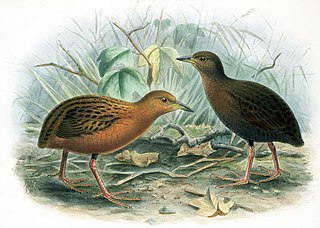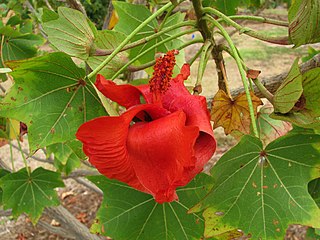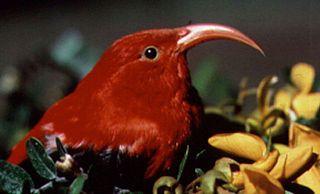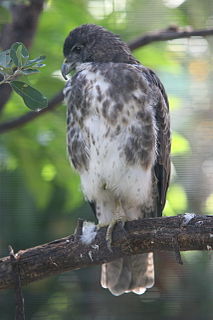
The ʻelepaios are three species of monarch flycatcher in the genus Chasiempis. They are endemic to the Hawaiian Islands, and were formerly considered conspecific. They measure 14 cm long and weigh 12–18 g. One species inhabits the Big Island, another Oʻahu and the third Kauaʻi. Being one of the most adaptable native birds of Hawaiʻi, no subspecies have yet become extinct, though two have become quite rare.

The Northwestern Hawaiian Islands or Leeward Islands are the small islands and atolls in the Hawaiian island chain located northwest of the islands of Kauai and Niihau. Politically, they are all part of Honolulu County in the U.S. state of Hawaii, except Midway Atoll, which is a territory distinct from Hawaii and grouped as one of the United States Minor Outlying Islands. The United States Census Bureau defines this area, except Midway, as Census Tract 114.98 of Honolulu County. Its total land area is 3.1075 square miles (8.048 km2). All the islands except Nihoa are north of the Tropic of Cancer, making them the only islands in Hawaii that lie outside the tropics.

The poʻo-uli, or black-faced honeycreeper, is an extinct species of passerine bird that was endemic to the island of Maui in Hawaiʻi. It is considered to be a member of the Hawaiian honeycreepers, and is the only member of its genus Melamprosops. It had a black head, brown upper parts and pale gray underparts. This bird inhabited only the drier, easternmost side of Maui, where it had rapidly decreased in numbers. With extinction threatening, efforts were made to capture birds to enable them to breed in captivity. This has been largely unsuccessful; in 2004, only two known birds remained, and since then, no further birds have been sighted. A 2018 study recommended declaring the species extinct, citing bird population decline patterns and the lack of any confirmed sightings since 2004, and in 2019, the species was declared extinct.

The Hawaiian rail, Hawaiian spotted rail, or Hawaiian crake is an extinct species of diminutive rail that lived on Big Island of Hawaiʻi.

Kokia cookei is a small, deciduous tree commonly known as the kokiʻo, Molokaʻi treecotton, Cooke's kokiʻo, or Molokaʻi kokiʻo.

Ciridops is an extinct genus of Hawaiian honeycreeper species that occurred in prehistoric and historic times on the Hawaiian islands of Hawaii, Molokai, Kauai and Oahu. This genus was created in 1892 by Alfred Newton in an article published by the journal Nature on the basis of the ʻula-ʻai-hawane, which was named Fringilla anna by Sanford B. Dole in 1879.
The highland finch is an extinct member of the Fringillidae and a Hawaiian honeycreeper which is known only from a few bones found in caves. It is the only member of the genus Orthiospiza. It was endemic to the high-elevation areas of Mount Haleakalā on the Hawaiian island of Maui. It has been speculated that they were pushed to extinction because of habitat loss. It is known only from fossil remains and likely became extinct before the first Europeans arrived in 1778.
The Kauai finch is an extinct bird in the genus Telespiza of the family Fringillidae. It was endemic to the Hawaiian islands of Kauai and Oahu. It is only known from fossil remains and likely became extinct before the first Europeans visited Hawaii in 1778.
The Maui Nui finch is an extinct member of the genus Telespiza in the family Fringillidae. It was endemic to the Hawaiian islands of Molokai and Maui. It is only known from fossil remains and likely became extinct before the first Europeans visited Hawaii in 1778.
The wahi grosbeak or Oʻahu grosbeak is a prehistoric species of Hawaiian honeycreeper. The wahi grosbeak was endemic to dry forests on the Hawaiian islands of Kauaʻi, Oʻahu, and Maui. Based on the thickness of its bill it fed on seeds easier to crack than those of the naio, on which the Kona grosbeak fed. The species was already extinct when Europeans landed on the island. Being only known from fossils, its behavior and the exact reasons for its extinction are essentially unknown. Its fossils have been found throughout the islands, but were present in higher concentrations in caves. The bird was smaller than the related King Kong grosbeak by 2 inches (5.1 cm). It had a total length of 9 inches (23 cm).
The King Kong grosbeak or giant grosbeak is a prehistoric species of Hawaiian honeycreeper, that was endemic to Hawaiʻi. It had the largest beak of the three Chloridops species known to have existed. The King Kong grosbeak was described from fossils found at Barber's Point and Ulupau Head on the island of Oʻahu. It was 11 inches (28 cm) long, making it one of the largest Hawaiian honeycreepers. The osteology of the mandible strongly suggests that C. regiskongi was a sister-taxon of Rhodacanthis.

The high-billed crow or deep-billed crow was a species of large, raven-sized crow that was endemic to the island of Maui in the Hawaiian Islands. It was pushed to extinction due to the arrival of people and pests like rats.
Xestospiza is a genus containing two species of birds with cone-shaped bills that were described on the basis of fossils. They were possibly insectivores. It consists of the following:
Paleontology or palaeontology is the study of prehistoric life forms on Earth through the examination of plant and animal fossils. This includes the study of body fossils, tracks (ichnites), burrows, cast-off parts, fossilised feces (coprolites), palynomorphs and chemical residues. Because humans have encountered fossils for millennia, paleontology has a long history both before and after becoming formalized as a science. This article records significant discoveries and events related to paleontology that occurred or were published in the year 1991.
The stout-legged finch is an extinct species of finch, in the 'Hawaiian honeycreeper' group. Subfossil remains have been found only on the island of Kauai and indicate that it survived up until the late Quaternary period. It probably died out when the first humans arrived in the Hawaiian Islands. The stout-legged finch would have been very vulnerable to the pests and agriculture that the humans brought with them. It was a congener of the 'ula-'ai-hawane, and therefore probably had similar colors of red, white and black.

Hawaiian honeycreepers are small, passerine birds endemic to Hawaiʻi. They are closely related to the rosefinches in the genus Carpodacus. Their great morphological diversity is the result of adaptive radiation in an insular environment.

The Makauwahi Cave is the largest limestone cave found in Hawaii. It lies on the south coast of the island of Kauaʻi, in the Māhāʻulepū Valley close to Māhāʻulepū Beach, and is important for its paleoecological and archaeological values. It is reached via a sinkhole and has been described as “…maybe the richest fossil site in the Hawaiian Islands, perhaps in the entire Pacific Island region”.
Xestospiza fastigialis is an extinct species of bird with a ridge-shape bill that was described on the basis of fossils. It was possibly an insectivore, populating the Hawaiian Islands of Oahu, Molokai and Maui.

The Hawaiian hawk (Hawaiian:ʻio) is a raptor in the genus Buteo endemic to Hawaiʻi, currently restricted to the Big Island. The ʻio is the only bird of prey that is native to Hawaiʻi, and fossil evidence indicates that it inhabited the island of Hawaiʻi, Molokaʻi, Oʻahu, and Kauaʻi at one time. Today, it is known to breed only on the Big Island, in stands of native ʻōhiʻa lehua trees. The species was protected as an endangered species in the United States, but was delisted in 2020. However, the IUCN classifies the species as Near Threatened.









